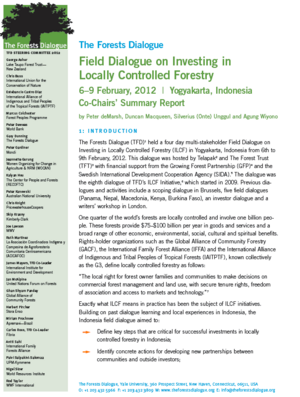Co-Chairs’ Summary: Eighth Dialogue on ILCF - Indonesia Field Dialogue
The Forests Dialogue (TFD) held a four day multi-stakeholder Field Dialogue on Investing in Locally Controlled Forestry (ILCF) in Yogyakarta, Indonesia from 6th to 9th February, 2012. This dialogue was hosted by Telapak and The Forest Trust (TFT) with financial support from the Growing Forest Partnership (GFP)4 and the Swedish International Development Cooperation Agency (SIDA). The dialogue was the eighth dialogue of TFD’s ILCF Initiative, which started in 2009. Previous dialogues and activities include a scoping dialogue in Brussels, five field dialogues (Panama, Nepal, Macedonia, Kenya, Burkina Faso), an investor dialogue and a writers’ workshop in London.
One quarter of the world’s forests are locally controlled and involve one billion people. These forests provide $75–$100 billion per year in goods and services and a broad range of other economic, environmental, social, cultural and spiritual benefits. Rights-holder organizations such as the Global Alliance of Community Forestry (GACF), the International Family Forest Alliance (IFFA) and the International Alliance of Indigenous and Tribal Peoples of Tropical Forests (IAITPTF), known collectively as the G3, define locally controlled forestry as follows:
“The local right for forest owner families and communities to make decisions on commercial forest management and land use, with secure tenure rights, freedom of association and access to markets and technology.”
Exactly what ILCF means in practice has been the subject of ILCF initiatives.Building on past dialogue learning and local experiences in Indonesia, the Indonesia field dialogue aimed to:
- Define key steps that are critical for successful investments in locally controlled forestry in Indonesia;
- Identify concrete actions for developing new partnerships between communities and outside investors;
- Understand how to best leverage LCF to access financing mechanisms, including REDD+.
The Indonesia dialogue brought together 21 international and 32 local stakeholder groups representing indigenous people, local community, small land owners, forestry investors and companies, development assistance agencies, national and local governments, inter-governmental organizations, and international and national non-governmental organizations (see participant list in Annex).
This report summarizes key observations and discussions from the dialogue.

